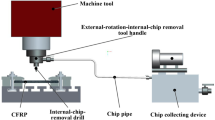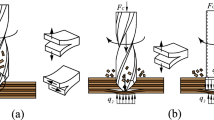Abstract
In order to meet the requirements of green, high-efficiency, and high-quality hole-machining in carbon fiber reinforced polymer (CFRP), firstly, this work introduces the suction-type internal-chip-removal system, which could discharge the chips formed in the CFRP drilling process in a timely and efficient manner. And based on the system working principle, the design basis of the inner flow channel of the suction-type internal-chip-removal drill system is provided. Secondly, we studied the influence of the PCD drill structural parameters on the drilling force by experiment and obtain the conclusion that the drilling force will be increasing when the front angel is getting larger under the drilling parameters of n = 3000r/min and f = 200mm/min; however, it increased slowly when the front angel (γ1) is in the range of 118 ° ≤ γ1 < 130°. Meanwhile, with the increase of the rear angle (α), the drilling force increases first and then decreases. Then, based on the research results above and combined with experiment and simulation of ABAQUS User subroutine to define material behavior (VUMAT), we completed the design of PCD double-peak angel blade for suction-type internal-chip-removal drill. Finally, we manufactured the drill for suction-type internal-chip-removal system, verified the accuracy of the design by experiment comparison, and researched the influence of chip-removal negative pressure on drilling defect.
















Similar content being viewed by others
References
Krishnamoorthy A, Boopathy SR, Palanikumar K, Davim JP (2012) Application of grey fuzzy logic for the optimization of drilling parameters for CFRP composites with multiple performance characteristics. Measurement 54(4):1286–1296
Lou B, Li Y, Zhang KF, Cheng H, Liu SN (2015) A novel prediction model for thrust force and torque in drilling interface region of CFRP/Ti stacks. Int J Adv Manuf Technol 81(9-12):1497–1508
Perez JLM, Royer R, Merson E, Lockwood A, Soberanis SA, Marshall MB (2016) Influence of workpiece constituents and cutting speed on the cutting forces developed in the conventional drilling of CFRP composites. Compos Struct 140(15):621–629
Wang FJ, Yin JW, Ma JW, Jia ZY, Yang F, Niu B (2017) Effects of cutting edge radius and fiber cutting angle on the cutting-induced surface damage in machining of unidirectional CFRP composite laminates. Int J Adv Manuf Technol 91(9-12):3107–3120
Su F, Zheng L, Sun FJ, Wang ZH, Deng ZH, Qiu XY (2018) Novel drill based on the step-control scheme for reducing the CFRP delamination. J Mater Process Tech 262:157–167
Montoya M, Calamaz M, Gehin D, Girot F (2013) Evaluation of the performance of coated and uncoated carbide tools in drilling thick CFRP/aluminium alloy stacks. Int J Adv Manuf Technol 68(9-12):2111–2120
An QL, Chen J, Cai XJ, Peng TT, Chen M (2018) Thermal characteristics of unidirectional carbon fiber reinforced polymer laminates during orthogonal cutting. J Reinf Plast Comp 37(13):905–916
Meng QX, Jiang SS, Liu SN, Zhang KF, Yan XY (2018) Study of thrust force distribution in a drilling cycle during drilling of CFRP laminates. J Mech Eng 54(11):110–120
Chen M, Qiu KX, Qin S, Wang CD, Cai XJ (2014) Study on drilling behaviors and defects forming process of high-strength CFRP laminates. J Nanjing U Aeronaut Astronautics 46(5):667–674
Chen T, Gao F, Li SY, Liu XL (2018) Experimental study on cutting tool wear in milling carbon fiber composites with spiral staggered diamond-coated milling cutter. Int J Adv Manuf Technol 98(1-4):413–419
Lazer MB, Xirouchakis P (2011) Experimental analsis of drilling fiber reinforced composites. Int J Mach Tool Manu 2(51):937–946
Kou C, Wang C, Ko S (2018) Wear behaviour of CVD diamond coated tools in the drilling of woven CFRP. Wear 18(398-399):1–12
Wang FJ, Qian BW, Cheng D, Jia ZY, Fu Y, Yin JW (2018) Wear of one-shot drill in drilling CFRP and novel method for tool wear reduction. J Mech Eng 54(15):171–179
Karpat Y, Bahtiyar O, Deger B, Kaftanoglu B (2014) A mechanistic approach to investigate drilling of UD⁃CFRP laminates with PCD drills. CIRP Ann-Manuf Techn 63:81–84
Xu JY, An QL, Chen M (2014) A comparative evaluation of polycrystalline diamond drills in drilling high strength T800S/250F CFRP. Compos Struct 117:71–82
Karpat Y, Bahtiyar O (2015) Tool geometry based prediction of critical thrust force while drilling carbon fiber reinforced polymers. Adv Manuf 4(3):200–208
Tagliaferri V, Caprino G, Diterlizzi A (1990) Effect of drilling parameters on the finish and mechanical properties of GFRP composites. Int J Mach Tool Manu 30(1):77–84
Tsao CC, Hocheng H (2004) Taguchi analysis of delamination associated with various drill in drilling of composite material. Int J Mach Tool Manu 44(10):1085–1090
Ogawa K, Aoyama E, Inoue H, Hirogaki T, Nbe H (1997) Investigation on cutting mechanism in small diameter drilling for GFRP (thrust force and surface roughness at drilled hole wall). Compos Struct 38(1-4):343–350
Tsao CC (2006) The effect of pilot hole on delamination when core drill drilling composite materials. Int J Mach Tool Manu 46(12–13):1653–1661
Xu CY, Wang YW, Xu JZ, Liu XL (2018) Calculation of negative-pressure chip in suction-type internal chip removal system and analysis of influencing factors. Int J Adv Manuf Technol 99(1-4):201–209
Wang YW, Xu CY, Xu JZ, Liu XL (2019) Simulation analysis and experimental study on chip removal conditions of internal chip removal for CFRP machining. J Mech Eng 55(5):223–231
Hobbiebrunken T, Fiedler B, Hojo M, Ochiai S, Schulte K (2005) Microscopic yielding of CF/epoxy composites and the effect on the formation of thermal residual stresses. Compos Sci Technol 65:1626–1635
He H (2011) Researches on the thrust force and holes quality in drilling CFRP. Nanjing University Of Aeronautics And Astronautics
Acknowledgments
Thanks #to the National Natural Science Foundation Project (51475127) for supporting the research of this subject.
Author information
Authors and Affiliations
Corresponding author
Additional information
Publisher’s note
Springer Nature remains neutral with regard to jurisdictional claims in published maps and institutional affiliations.
Rights and permissions
About this article
Cite this article
Xu, C., Wang, Y., Xu, J. et al. Design of internal-chip-removal drill for CFRP drilling and study of influencing factors of drilling quality. Int J Adv Manuf Technol 106, 1657–1669 (2020). https://doi.org/10.1007/s00170-019-04698-8
Received:
Accepted:
Published:
Issue Date:
DOI: https://doi.org/10.1007/s00170-019-04698-8




